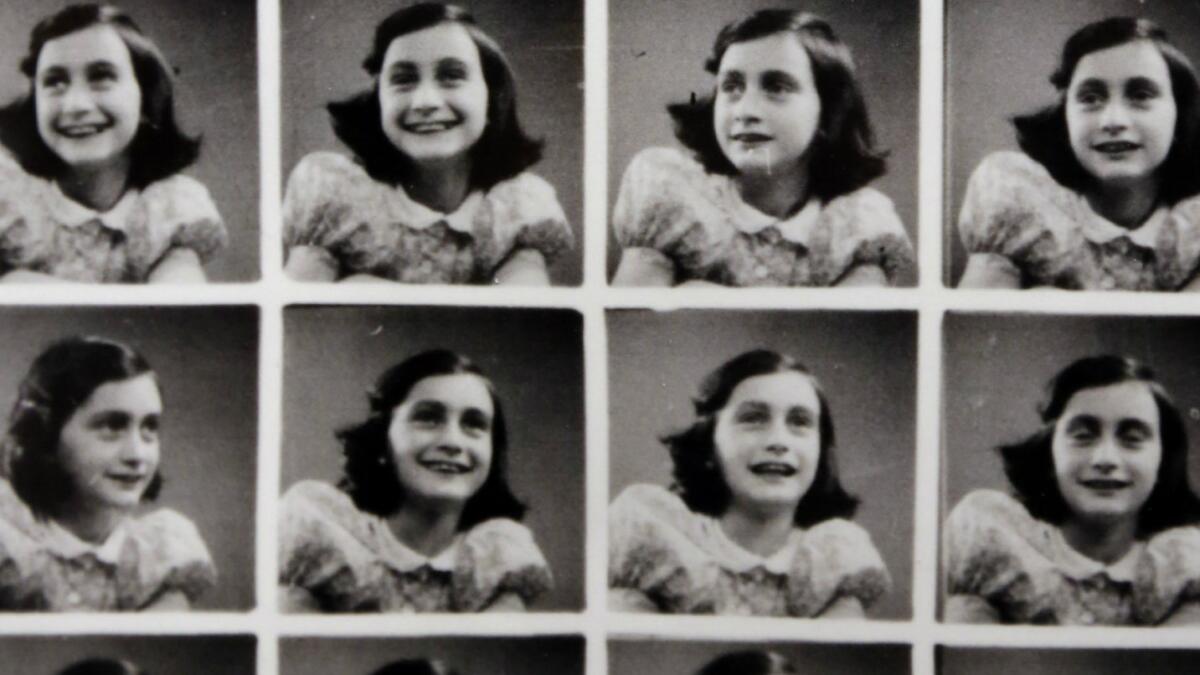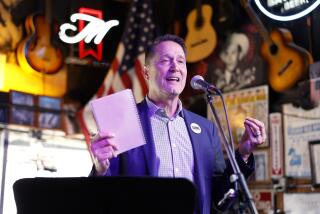Column: The squabble over Anne Frank’s diary shows the absurdity of copyright law

Part of a page of passport-sized photos taken of Anne Frank at a department store before she went into hiding in Amsterdam in 1942, displayed at the Museum of Tolerance in 2013.
It’s a fair bet that Anne Frank never expected her diary to be published, though she may have wished it to be preserved. It’s also unlikely that she ever considered her father, Otto, to be treated as her “co-author.”
We can’t know because she perished at the age of 15 in the Bergen-Belsen concentration camp, leaving behind the unique documentary record of life with her Jewish family in hiding from the Nazis in the secret annex of an Amsterdam warehouse.
But legal issues still swirl about the diary, the copyright to which is asserted by the Swiss-based Anne Frank Fonds, which was established by Otto Frank before his death in 1980. One year ago, the foundation issued a stern reminder that it intended to protect its copyrights for many decades after they would have expired, as early as this January in Europe.
It is wrong to assume that the copyrights to Anne Frank’s Diaries would be due to expire in the near future.
— Anne Frank Fonds
“It is wrong to assume that the copyrights to Anne Frank’s Diaries would be due to expire in the near future, or that anyone would be free to use and publish them without permission,” the organization said. More recently, the foundation unveiled its rationale for extending the copyright to 2050 in Europe: According to the Toronto Globe and Mail, it’s listing Otto Frank as the work’s “co-author,” which preserves the copyright for 70 years after his death.
The foundation dedicates all the earnings from the diary to charitable ends, but its move underscores what many copyright experts and public advocates see as a disturbing perversion of copyright principles. Instead of providing a limited monopoly to creators to promote the flow of artistic works to the public, it’s become a practically limitless source of income to creators’ heirs--sometimes generations removed--and corporate rights holders.
“There’s no way a 95-year copyright term is an incentive for anyone to create anything,” says Dennis Karjala, a law professor at Arizona State who led the opposition to the Copyright Term Extension Act, the 1998 federal law known as the Sonny Bono Act after its chief promoter in Congress. The act set copyright duration at the author’s life plus 70 years, or 95 years after publication for works done for hire.
The act wasn’t aimed at encouraging artistic expression, Karjala says. It was pushed by corporate entities such as the Walt Disney Co., which would soon lose rights to the earliest films featuring Mickey Mouse. “They were all concerned about the cutoff of the royalty spigot,” Karjala says.
Rather than promote the flow of works into public view, copyright here and abroad has become a tool for keeping works out of the public domain. By asserting copyright over the Rev. Martin Luther King Jr.’s public speeches, the civil rights leader’s heirs arguably have narrowed public access to his words.
The King family stringently controlled broadcasting of King’s seminal “I Have a Dream” speech without royalty payments, even on and around Aug. 28, 2013, the 50th anniversary of its delivery on the Washington Mall.
The film “Selma,” which related King’s role in the 1965 protests in support of the Voting Rights Act, showed King speaking rewritten and paraphrased versions of his speeches, according to its director, Ava DuVernay, because the film rights had been sold to Steven Spielberg for an as-yet unproduced project. In any case, she suggested, acquiring the rights from the King family would have meant accepting them into “a certain collaboration” in how King was portrayed.
Similar issues have arisen regarding how Anne Frank has been portrayed through her diary, although the grounds for claiming the copyright are different. (The U.S. copyright will last to 2047, or 95 years after its first U.S. publication in 1952.) The diary exists in three source versions: the A diary, comprising her bound diary and three handwritten notebooks; B, which she recompiled into a single narrative after a public appeal by a Dutch minister for the preservation of documentation of the Nazi regime; and C, which Otto Frank assembled from remnants of the other two that were given him after the war as his family’s sole survivor.
It’s the last version on which the foundation bases its designation of Otto Frank as “co-author.” But it observes that other versions may have even longer-lived protections, including translations and a full edition of all Anne Frank’s writing released in 1986, which in some countries might be copyrighted through 2056.
Then there’s the “definitive” version, issued in the U.S. in 2011, which includes material revealing Anne as a much more three-dimensional teenager with hints of willfulness and sexuality, which Otto Frank excluded from the original publication as too personal.
Would that material have reached the public sooner, if not for the grip of copyright protection? Possibly. That points to the question of how the ever-tighter cinch of copyright law is used to thwart the public interest. The works of Anne Frank and the Rev. Martin Luther King Jr. are unusual, even unique, objects of copyright protection because of their creators’ unique grip on our culture and our imagination.
It’s understandable that their heirs might wish to maintain some control over how the works are distributed and their creators portrayed. But should they have such a right for decades to come? In such cases copyright law is an obstacle, not an inducement, to public understanding.
Keep up to date with the Economy Hub. Follow @hiltzikm on Twitter, see our Facebook page, or email [email protected].
MORE FROM MICHAEL HILTZIK
Are daily fantasy sports contests gambling or games of skill?
Why UnitedHealth’s threat to pull out of Obamacare isn’t as scary as it seems
More to Read
Inside the business of entertainment
The Wide Shot brings you news, analysis and insights on everything from streaming wars to production — and what it all means for the future.
You may occasionally receive promotional content from the Los Angeles Times.











